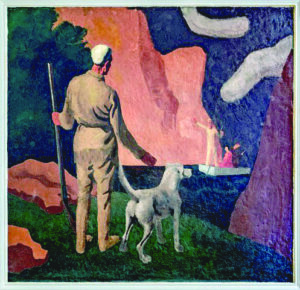Dedication, invention, perseverance lead to a
surprising, happy ending for the Fenimore Cooper murals

[Editor’s note: We’ve been following the story of the James Fenimore Cooper murals in Mamaroneck doomed to a future hidden from view or lost forever to school reconstruction. There’s good news to report this week, and we asked Carol Bradshaw Akin, Board Member and former President of the Mamaroneck Historical Society, to give us a first-person, on-the-ground report. It’s a wonderful story with a happy ending — something nice for a change — and a real connection between Otsego and Westchester counties. Thank you, Carol!]
There’s good news to report, thanks to the superhuman efforts of the Co-Presidents of the Mamaroneck Historical Society, John Pritts and Gail Boyle, who turned their lives inside out for the past two-plus months to save eight murals of James Fenimore Cooper’s scenes from “Leatherstocking Tales” painted 81 years ago. Ninth grade classes at Mamaroneck Junior High fund-raised from 1936 to 1941, then hired artists from Yale Art School, one of whom, Mimi Jennawine, was a Mamaroneck High graduate. Her other works include a painting in the Smithsonian — and most all of the other muralists went on to become prominent artists.
With GoFundMe contributions, and a couple of generous large donors, the figure needed was reached, and John and Gail began. They threw themselves into this almost impossible task, researching information, and contacts, searching for mural-removal companies (found one), hired an art conservator, wrote and followed up on hundreds of emails, spent hours and days on phone calls, tried (in vain) to be in touch with the School Board and Superintendent, (eventually found the school’s Director of Facilities who was supportive and cooperative!), drove all over from Stamford, CT, to Brooklyn to pick up preservation supplies needed by the company, which also included huge 2ft x 12ft tubes on which to roll the murals. And then once the work began, they supervised all of the work every day at the high school.
After the removal process had begun, our Historical Society Board received an email update from the high school, saying that the murals removal company and art conservator had told them the glue holding the murals to the wall was just as hard as 81 years ago. The process of removal became painstakingly slow. This was the first week in April — and they were given an extension only to April 7 (from April 1) by the School Board. John called from the school to warn that there was no way, in that time, they could remove more than four of the murals.
But — the next day, the removal company brought in a second crew that worked into the night — and succeeded miraculously in saving all eight of them, safely removing seven! The eighth mural stands in a science classroom with gas and water lines too near it to build a scaffold. It now is totally protected behind plexiglass, and will be behind a wall of the school’s new Tech Lab.
The mural, Mimi Jennewein’s “European Journeys and Influences 1826-1833,” will have a sign on the Tech Lab wall noting the mural that is behind it. Perhaps sometime in the future, it could be retrieved.
We are all elated at what they were able to do!, John wrote again, describing the complicated process, after the completion:
“The mural removal team was PHENOMENAL! Led by Josh Lattrell of ACA Environmental Services, Inc., the team problem-solved their way through endless challenges. They invented special rigs to work in tight spaces. They figured out what worked for removal of each mural depending on the wall surface and the strength of the adhesive. The 81-year-old glue used to adhere the canvas to the walls was like cement. The removal team got into a rhythm, synchronizing their efforts while standing on a scaffold beneath the suspended tube, which wrapped the mural towards the ceiling, while carefully scraping the glue, inch by inch, to release the mural.”
We are leaving the GoFundMe link on on our website (mamaroneckhistoricalsociety.org) as there will be a huge cost to restore and hang the murals in local public buildings in Larchmont and Mamaroneck. John explained, “The seven murals that were successfully removed will require a range of restoration services. One of them was extremely brittle, resulting in loss of paint. The canvas on other murals was thin or torn in some places, requiring repair. This will mean another large cost for repairs. Although not the outcome we had hoped for, we are confident that all involved in the removal effort worked above and beyond to preserve all of the murals. while coming off the wall.”
After being in the Junior High cafeteria, which later became part of Mamaroneck High School, for 81 years, having classrooms built in the huge cafeteria in the ‘90s, obscuring the murals from being seen at a distance, the murals will eventually hang in public buildings in Mamaroneck and Larchmont. In the future, the entire community will be able to see and appreciate these beautiful, historic murals and the first truly American novelist, James Fenimore Cooper.

